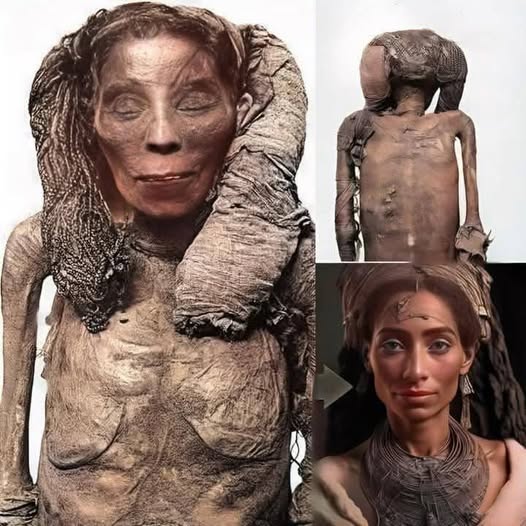In the world of archaeology, certain discoveries serve not just as isolated finds but as bridges between past and present, unlocking doors to long-forgotten civilizations and transforming our understanding of history. One such remarkable case is that of Lady Rai, an ancient Egyptian woman who lived over 3,500 years ago during the 17th Dynasty, in the twilight years before Egypt’s New Kingdom truly flourished. Though she may not have held the titles of pharaoh or queen, Lady Rai’s significance in the narrative of ancient Egyptian history is undeniable. Known primarily as the nursemaid to Queen Ahmose-Nefertari—the powerful matriarch of Egypt’s royal family—Lady Rai lived a life of quiet influence within the royal court. Yet it is not merely her connection to royalty that fascinates historians and scholars, but the extraordinary condition of her remains, which have become an essential source of insight into the practices, technologies, and health of one of the world’s most iconic ancient civilizations.

Lady Rai’s mummy was discovered in the early 20th century in the Deir el-Bahari cache, a tomb complex that housed the remains of several royals and high-status individuals. Unlike many mummies that were looted, damaged, or poorly preserved, Lady Rai’s body had endured the passage of time with astonishing integrity. Her face, serene and unblemished, bore a startling resemblance to a sleeping woman rather than a corpse of millennia past. The meticulous nature of her mummification—the way her features were preserved, the tightness and fineness of the linen wrappings, and the use of embalming materials—astonished researchers, many of whom were used to finding more deteriorated specimens. Her body was wrapped in high-quality, finely woven linen, and traces of resins and oils suggested a level of care and sophistication typically reserved for individuals of high esteem. This was no ordinary burial; Lady Rai had clearly been honored in death as she had been in life.
The discovery of her mummy sparked immediate interest not only from Egyptologists but also from scientists in various fields. Radiological and CT scans revealed details that further emphasized the medical and ritualistic brilliance of the embalmers. Notably, Lady Rai’s organs had been removed and treated with substances to prevent decay—a hallmark of advanced embalming that predated the peak of such techniques in Egypt’s later dynasties. Her preservation reflects a profound understanding of human anatomy, chemistry, and spiritual belief, all of which played critical roles in ancient Egyptian burial rites. The Egyptians believed that preserving the body was vital for the soul’s journey into the afterlife. In their view, bodily decay could jeopardize a person’s eternal existence, and so embalmers took painstaking steps to guard against it. Lady Rai’s condition centuries later served as a powerful validation of these beliefs and practices.
However, the scientific revelations didn’t end with embalming. When researchers performed medical imaging on Lady Rai’s remains, they were stunned to find evidence of atherosclerosis, a condition in which the arteries harden and narrow due to the buildup of plaque. This was a game-changer. Up until then, it was commonly assumed that heart disease was a modern affliction, caused by contemporary diets, sedentary lifestyles, and industrialized stress. But Lady Rai, who lived in a time with no processed foods, minimal sugar intake, and a physically active daily life, had clearly suffered from this condition. Her case was among the earliest confirmations that cardiovascular disease is not a byproduct of modernity alone, but a condition with roots deep in human history.
This finding has opened up new pathways in the field of paleopathology—the study of ancient diseases. If atherosclerosis existed in a civilization as old as ancient Egypt, it raises critical questions about genetic predisposition, environmental stressors, and other potential causes unrelated to modern lifestyles. Lady Rai’s remains became more than a historical artifact; they became a time capsule of human health, offering clues that continue to inform medical research today. Subsequent studies on other mummies across different eras and regions have only supported this surprising discovery, but it was Lady Rai who served as the catalyst.
Beyond the medical insights, her story also sheds light on the social fabric of ancient Egypt. Though not of royal blood, her status as a royal nursemaid suggests she held a revered position, likely close to the family she served. In a society where the line between the divine and mortal was often blurred, those entrusted with the care of royal offspring were often granted high social regard. Her burial within proximity to the elite and the level of craftsmanship in her mummification both point to a life lived in a respected, possibly even cherished, role within the royal household. She may have been a confidante, a guardian, or even a spiritual guide to Queen Ahmose-Nefertari, who herself was later deified and worshipped as a goddess.
Today, Lady Rai’s mummy resides in the Egyptian Museum in Cairo, where it continues to be studied and admired by visitors from around the world. Her story is one of silent legacy—of a woman whose contributions during her life may have been private and domestic, yet whose death has had an outsized impact on the understanding of ancient civilization. Through Lady Rai, we gain a more intimate, more human glimpse into the world of ancient Egypt—a place often viewed through the lens of grandeur, kings, and temples, but which was also home to caretakers, healers, and women like her whose stories still echo through time.
Her body may rest in silence, but her legacy speaks volumes. She represents not just a connection to an ancient world, but also a reminder of the universality of human experience—of health and illness, love and duty, life and death. In death, Lady Rai has done what few ever could in life: she has transcended time, becoming both an archaeological marvel and a symbol of enduring humanity. As science advances and new techniques emerge, who knows what further secrets she may still yield? But one thing is certain—Lady Rai’s story is far from over.
